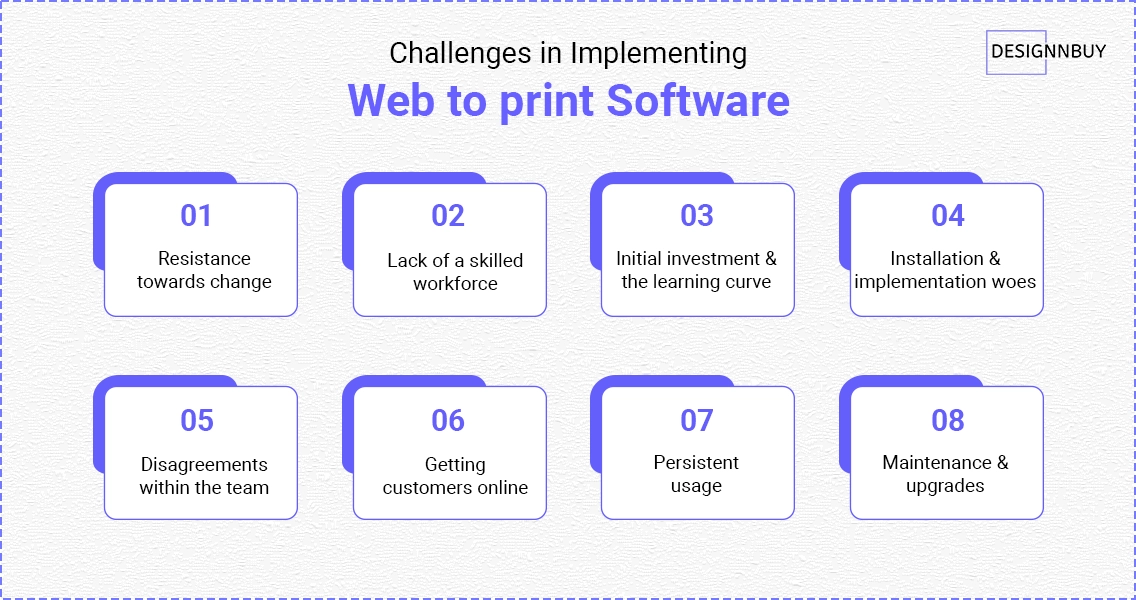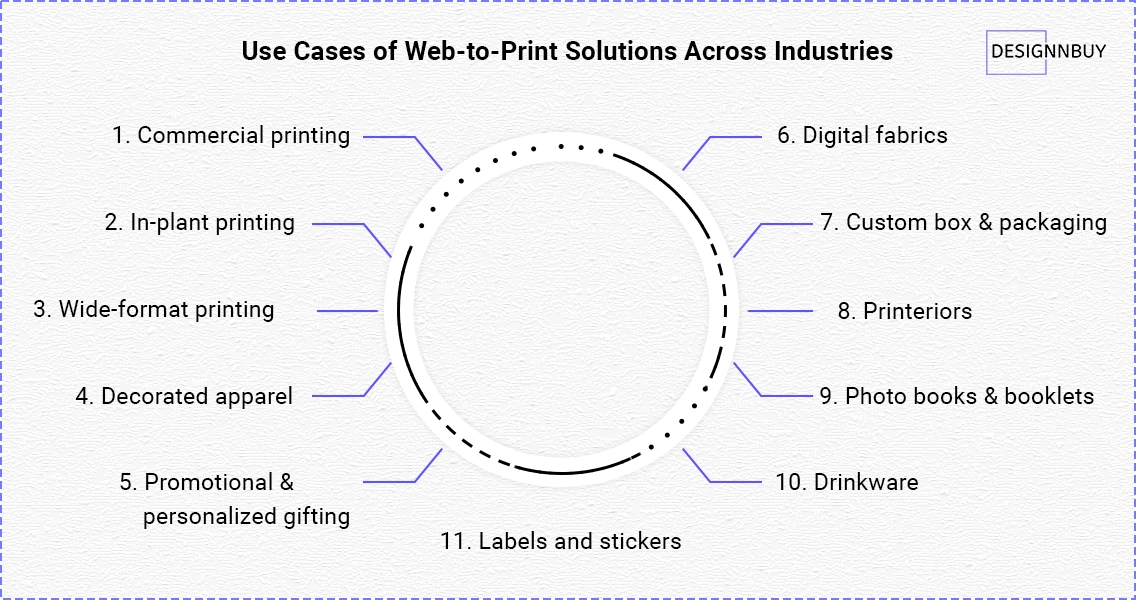In our last blog of this series of Web-to-Print Complete guide we learned that what is Web-to-Print solution and how it works. What are the digital printing trends and how implementing Web-to-Print can help you as well as your clients.
What are the Challenges in Implementing Web-To-Print Software ?
Change is inevitable. But change is also often met with much resistance. Fifty-eight percent of online printing companies once surveyed revealed that the customer utilization rate of the storefront was as less as 5 percent, as compared to the industry standard, which is 11 percent. (NAPL)
Another reason why online printers are unable to make the most of this technology is that their in-house team finds it difficult to adapt to the new system. So, yes. Despite significant benefits, web-to-print implementation is challenging.
Let us study these challenges in greater detail in the following sections:

1. Resistance towards change
As mentioned earlier, both potential customers and employees are often hesitant when it comes to using a web-to-print solution because they are comfortable using an older more familiar method. The resistance comes especially from those who do not understand the technology.
Therefore, it is essential for you to make them understand that a web-to-print solution is more convenient to use, reduces inefficient in-house processes, and ensures a quicker turnaround time for all orders.
Your team should also be equally comfortable in using the software. Run a few training sessions with them to explain the nuances of web-to-print technology.
2. Lack of a skilled workforce
Lack of a skilled workforce is a global phenomenon, which even online printers can’t escape. Therefore, if you assign the responsibility of managing the storefront to someone in your team, make sure they have the required skills and sufficient technical knowledge. Else, you can risk the whole motive of adopting a web-to-print solution.
The person you appoint need not be a software developer but should understand and master how the system works once it has been installed and is up and running. Proficiency in working on online applications and internet literacy is a must for operating your online channel of business.
In addition, your team should be capable of identifying software glitches and getting them fixed; configuring the system to set it up as per your business processes and products and services you like to offer online; resolving disk space or server access issues; and performing routine website management tasks with ease.
Exclusive: Click here Print Outsourcing Made Easy with Web-to-Print [ A Complete Guide ]
3. Initial investment and the learning curve
The implementation and rollout of a web-to-print storefront are risky because it involves massive initial investments. Come to think of it – it is essentially an ecommerce website – selling commercial printing services to consumers.
This could present a challenge for you if you are unsure if the web-to-print storefront will bring you excellent value. Therefore, if you do plan to implement this technology, please remember that it will not only cost you money and time but also be a steep learning curve for you.
4. Installation and implementation woes
A significant challenge is the installation of the web2print software. The web-to-print application requires a robust server infrastructure with proper backup and security measures. As it is a direct channel of revenue for your business, you need to ensure it is up and running 24×7, as many of you may not have experienced IT teams to manage the servers.
In some instances, when you try to integrate two systems – for example, an MIS you are using and a web2print software – it may lead to further complexity and unprecedented delays.
The primary objective in the installation of a web-to-print software is to ensure that the system runs smoothly, with no delays. You can take help from your web-to-print software provider for a fail-proof implementation and ongoing maintenance.
5. Disagreements within the team
In certain situations, some of the key members of the management team may fail to recognize the advantages that a print commerce system can bring into the business.
One way to resolve this is by involving critical decision-makers from the start to understand the benefits of the technology in terms of cost savings and faster turnaround times, and how it can add value to your printing business.
It would really help to present them a deck with user cases of online printing companies that have implemented web-to-print technology and flourished in all aspects of the business. It may take a while for you to bring the top management up to speed; however, it is not impossible.
6. Getting customers online
Another major challenge printing companies face is persuading their end customers to use the web-to-print software consistently.
Traditionally, printing deals with massive paperwork and offline tasks. But with web-to-print software, you can get your end customers to make the transition with a more digital approach. This can happen if you help them understand the process of using the software.
Once your end customers recognize the benefits, it will become easier to get them to use your software a lot more than before.
7. Persistent usage
Choose any web to print software, and it will provide an instant quotation feature that enables consumers to choose details of their order – such as quantity to print, material type, and size of the artwork – to find out how much the printing job will cost. Real-time quotations saves time for both customers and print service providers.
8. Maintenance and upgrades
Periodic software upgrades enhance system performance and speed. Your in-house team must upgrade the web to print software regularly, as needed. Delaying upgrades can bring your website to a halt, and that can hamper the buying experience for your potential customers.
Therefore, it is vital that your in-house team regularly communicates with the IT department in your online printing company for guidance, and takes help for fixing impending software issues as and when the need arises.
Maintenance should also be carried as a best practice to ensure that your web-to-print storefront features always function optimally.
In which verticals has Web-to-Print Proven Results?
The global commercial print market remains in a forever state of transition. Significant business growth opportunities for printing companies are still on the rise.
The rampant advancement in technology, web-to-print technology in particular, has simplified the print buying process, making it possible for all consumers to personalize items and place orders in a span of minutes.
On top of that, online printing companies can offer a broader range of products, collaborate with consumers more easily, and produce printed orders faster.
Therefore, it doesn’t matter if you sell custom-decorated apparel or personalized packaging, or ready-for-print drinkware – there is potential in every domain, waiting to be tapped by online printing companies.
The good part is that web-to-print is not restricted to only one industry. It has spread its branches to a range of domains in the print market, and this section aims to give you an overview about all of them

1. Commercial printing
Commercial printing is simply defined as the process in which the artwork is transferred onto a piece of paper or card. As of today, it is one of the largest ecommerce industries in the world. Its revenue is expected to touch $821 billion by 2022. [Smithers Pira]
Web-to-print technology has transformed this domain by bridging the gap between digital files and print production in a shorter span.
2. In-plant printing
In-plant printers are not commercial printers; instead, they function just like any department of an organization, such as human resources, marketing, finance, or operations.
And they are most prevalent in colleges, universities, government offices, and other financial institutions that have massive internal printing requirements.
In-plant printers typically face many challenges in terms of limited budget and workforce allocation, accessibility, managing urgent requirements, printing in bulk, and lack of swift approval for copyrighting their materials.
Web-to-print technology allows individual departments to interact efficiently, upload their print jobs for processing, reprint previous orders in one click, create customized designs on approved templates, and order items from inventory for printing with ease.
The University of Oklahoma, one of the largest in-plant printers in the United States, uses the Variable Data Printing technique, which allows them to differentiate themselves from other universities and to make personal appeals to convince prospective parents and students to choose them.
3. Wide-format printing
The global market for wide-format printing is projected to reach 11.4 billion dollars by 2025. [Large Format Printer Market]
It is one of the most lucrative markets in the digital print industry. New applications continue to unfold as new substrates, inks, and marking technologies are being developed, leading to new opportunities for online printers in banners, soft signage, packaging, printeriors, and fabric printing. Major wide-format printers include Canon, HP, Konica Minolta, and Durst Group.
4. Decorated apparel
This industry has seen too many ups and downs owing to the ever-growing roster of choices in online competitors, printing suppliers, and home hobbyists who do their decorations. However, it is not all gloom and doom in the decorated apparel industry.
The average apparel order size is increasing, and social media seems to have proven a robust means of attracting a more extensive customer base and generating new leads. The desire for logoed apparel is as strong as ever, especially in the B2B spectrum. [Advertising Speciality Institute]
The global decorated apparel market size was valued at $26.75 billion in 2018 and is anticipated to expand at a CAGR of 10.91 percent by 2025. [Grand View Research]
Embroidery, screen printing, patches/emblems, vinyl letters design, and head transfers are the five services that seem to be driving the growth of the market, along with the use of Web-To-Print technology.
5. Promotional and personalized gifting
As an evolving industry, promotional gifting has shifted from picture frames and coffee mugs to more personalized items that have creative and innovative packaging, monogram engravings, personalized notes, and so on.
The global personalized gifts market is expected to grow by USD 15.92 billion during 2019-2023, and the market’s growth momentum will accelerate throughout the forecast period. In fact, MarketWatch predicts that the domain will grow by a CAGR of 9.52 percent by the year 2023.
6. Digital fabrics
Smithers Pira reports that the digital fabric print industry is set to increase by more than double in value by 2021, touching €2.42bn. An Allied Market Research study, on the other hand, predicts that the industry will achieve a CAGR of 17.9 percent, by 2022.
That is not surprising given that the digital fabrics industry has grown exponentially with printing techniques such as screen printing and direct to garment (DTG).
Let us take the t-shirt online printing business as an example. Not only are the t-shirts cheap to source and simple to customize but also the global market for such personalized items will soon be worth $10 billion by the year 2025. [Credence Research]
But that is not it. Web-to-print technology has enabled a platform for digital printing fabrics – from being able to choose the t-shirt material to evaluating total costs in real-time.
7. Custom box and packaging
A Dotcom Distribution study states 68 percent of customers think a brand becomes more upscale due to its packaging, and 61 percent of them get more excited to see a uniquely packaged delivery.
Licious.in is an India-based poultry company and online seller of meat and seafood, does a great job with its packaging. The brand uses the caricatures of its customers on the delivery boxes. No wonder, Licious.in always receives positive feedback for its unique packaging initiatives.
If you check their social media channels, you will find that their customers have posted pictures of the boxes on delivery. The act of social amplification automatically raises the bar for Liscious.in as a brand.
Do you know that the ecommerce packaging industry is set to be valued at $50 billion or that it is expected to grow to 14.3 percent by 2022? [Smithers Pira]
One of the significant perks of selling your custom packaging services is that it enables the consumers to design the boxes that better fit the product. They can also create corner pieces that keep the fragile products in place. Web-to-print technology offers this functionality
8. Printeriors
Printeriors first gained popularity in Europe back in 2015, when leading substrate manufacturers and digital printers joined hands to showcase a new range of applications targeted at the interior design communities in the region.
That opened the doors to new creative possibilities in Europe – where digital print technology could realize innovative interior design concepts in multiple domains such as commercial and residential real estate, retail, and hospitality.
Materials commonly used in such types of printing include metal, woods, glass, ceramic tiles, and Perspex. Don’t be surprised when we tell you that the room interiors in some European hotels are now entirely digitally printed. Isn’t that interesting?
It was only in 2018 that printeriors started to get traction in North America, with designers leveraging the advances of digital textile printing to develop on-demand bespoke cushions, furniture upholstery, carpets, table covers, drapes, and more – without minimum meterage.
This presents an excellent opportunity for online printing businesses to leverage web-to-print technology and enable consumers to get personalized home decor.
Moreover, thanks to the web-to-print business model, online printers don’t have to keep a large stock of pre-printed materials. They can order them as and when consumers demand for them, thus saving both cost and reducing wastage.
9. Photo books and booklets
In this time and age, personalized photo books are an increasingly popular product. You will be surprised to know that sales of this product were 25.4 million in 2018.
In fact, B2B production in the global print market represents 59.1 percent of the total sales, and much of this volume is in photo products and personal stationery alone!
Instead of killing off the printed page, web-to-print technology has enabled consumers to design and print their own books, the market value of which has risen by 2.7 percent since 2017.
Online sales continue to gain prominence, with only five percent of photobook sales in 2017 and 2018 made through offline mediums.
Not just that, web-to-print technology has allowed consumers to personalize and order high-quality booklets, photographs, and more such products at their convenience – and that too cost-effectively.
10. Drinkware
Technological advancements and changing lifestyles have prompted consumers to use products that are highly personalized, and the drinkware industry has seen a shift as well. The global market growth for tumblers, for example, is expected to reach $4.19 billion by 2026. [MarketResearch]
Drinkware such as tumblers, mugs, glassware, and ceramic drinkware are a huge ecommerce commodity as an increasing number of consumers are ‘going green’ and opting for eco-friendly and personalized options today.
The industry has been able to meet these demands with the help of web-to-print technology that makes personalizing beverage items possible – for instance, adding a company logo or a photograph on a coffee mug, and using specific colors for its design.
11. Labels and stickers
This industry thrives on personalization. Given the ever-increasing demand for more creative and innovative ideas, web-to-print technology has enabled consumers to design various types of items – such as product labels, photo labels, barcode labels, asset labels, packaging labels, and mailing labels – using customizable templates.
As of 2019, the print label market is valued at $39.17 billion, and it is expected to be worth $49.86 billion in 2025, at a CAGR of 4.11 percent from 2020-2025. [Mordor Intelligence]
So, online printers that haven’t adopted the web-to-print technology should do so to capitalize on that growth. After all, who doesn’t love to have the freedom to alter the sizes and shapes of their labels and stickers, and choose appropriate printing materials as per one’s requirement?
Success Stories of print business using Web-to-Print
In an age of rampant digital technological advancements, where every business is looking to carve a niche for themselves, web-to-print technology has empowered the print industry.
It has enabled printing businesses to leverage the inherent potential of the World Wide Web by allowing them to think beyond merely ‘offering print services’.
Today, online printers can not only reach a more extensive consumer base and streamline their ever-expanding service offerings but also offer their target customers an ‘optimal shopping experience’, which was tricky until a few years ago.
No wonder an increasing number of printing businesses are either talking about deploying web-to-print technology or are in the process of implementing it in their existing operational workflows. If there is one thing that our vast experience as a leading web-to-print software provider has taught us, it is that this technology can do wonders for your business.
Below are three compelling industry use cases of printing companies that transformed into growth machines thanks to web-to-print.
1. Designsta
W2P benefit: Advanced design template editing features for team banners
When a UK-based graphic designer, Louise Clarke, decided to start her own online visual design platform and membership group for female entrepreneurs, little did she know about the technological struggles that lay ahead of her.
The hosted solutions available in the market not only required her involvement in setting up servers but also came with a massive licensing fee and support expenses. Her dreams of creating a one-of-a-kind platform for women entrepreneurs would have been thwarted if it were not for web-to-print technology.
The chosen web-to-print vendor held a round of discussions to understand her business requirements better and to build a solution comprising desired feature specifications.
Louise wanted her customers to design digital assets for their businesses with ease, without paying heftily for using artwork or images by other graphic artists. She also wanted to offer this service as a subscription rather than charge per order.
The web-to-print software provider tailored their flagship design tool to fit her vision and budget – on the cloud, which required minimum upkeep. The result was an easy-to-update website, complete with tutorial videos, new templates, design elements, and a workbook.
2. FASteambanners
W2P benefit: Advanced design template editing features for team banners
Before the US-based online printer made a switch to web-to-print, FASteambanners only had a simple website with an old-fashioned Flash-based design tool. Due to the limited functionality, their customers were unable to change colors of clipart or use advanced design template editing features.
Also, once an order was placed online, the back office production team of FASteambanners could not edit customer-designed signs after downloading their created file. All these challenges led to a thinning customer base, high turnaround time, and a limited product catalog.
With web-to-print technology, they overhauled their website design, added a non-flash HTML5 design tool plus a support staff that understood their website and business inside out.
3. SilkLetter
W2P benefit: A B2B personalized shopping experience
Ever since its inception in 2008, SilkLetter, a New York-based B2B promotional product and corporate gifting printer, struggled to flourish. The biggest reason for the same was not offering personalization to its customer base.
After an exhaustive search, they realized they wanted a web to print online designer that was customized as per their industry requirements, and not merely a plug-and-play solution that the majority of vendors in the market provided.
When SilkLetter joined hands with their chosen web-to-print vendor, they spent months outlining the scope of work intricate to their niche and taking necessary actions to mitigate any risks in the future. As of today, SilkLetter has not reported a single website downtime, and their sales have increased manifold.
It is not a surprise that leveraging web-to-print technology in business processes has resulted in significant benefits to the printing companies.
Find your Why
Investing in web-to-print technology is like outsourcing. You outsource menial tasks such as sharing quotes, taking orders, getting artwork approval, and following up on payments.
With the help of the technology, your in-house team is freed of other tasks, and they can help in offering further high-end services such as on-demand marketing, web development, IT services, and more – all in the realm of printing.
Branching out will double or triple your annual sales and increase your ROI. You can tap new opportunities and ensure multiple incomes, rather than just focusing on one offering or service, which most businesses end up doing.
Now that you know the benefits you can reap from web-to-print technology, have you established the goals you would like to achieve with it? Is it to increase leads, increase conversions through sign ups or subscriptions, growth in brand interactions, or improve customer service?
Whatever your goals are, please know that this technology can do wonders for your business and subsequently boost your ROI.
Originally published on July 22, 2021 & Updated on Feb 9, 2023




